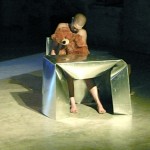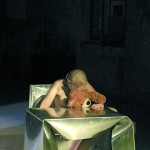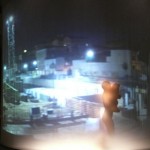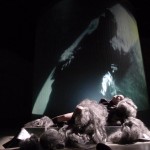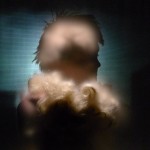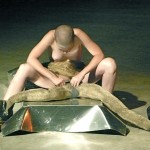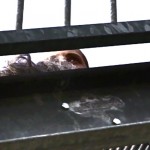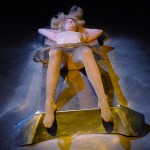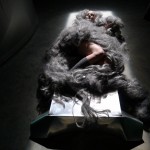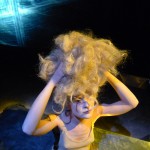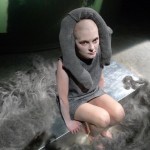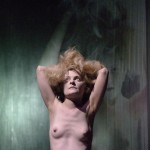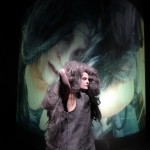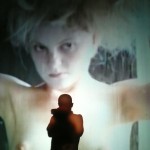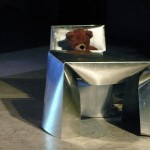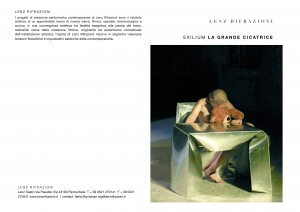
EXILE_THE GREAT SCAR
Exilium_The great scar is a visual poetic performance come on Sadness of Ovid and from Death fugue in Paul Celan, created by Maria Federica Maestri and Francesco Pititto, music by Andrea Azzali, interpreter Valentina Barbarini. In The Great Scar the verses of the Latin poet Ovid written from the land of exile in Tomi (the current Constance) in Romania they accompany the verses of the Romanian Jewish poet who lived in France, but he wrote in German – the language of the mother and of the Shoah – his best-known work ('death escape') dedicated to the horror of the Nazi genocide and extended to all suffering humanity.
Exilium_The great scar is part of the mapping of transmedia events dedicated to Celan's work carried out by the seven-year project PAUL CELAN IN ITALY 2007/2014 of the Department of European Studies, Americans and Interculturals of the University “Sapienza” From Rome.
The pairing/comparison is constructed through a visual and material dramaturgy defined by two female figures, Sulamith – the Beloved of the Song of Songs and symbolic personification of the Jewish nation – with ash-colored hair, testimony of the Jewish identity burned in the extermination camps of Hitler's Greater Germany and Margrete – the Beloved of Goethe's Urfaust, female literary symbol of the German nation – golden-haired woman of the nineteenth-century humanistic tradition. The visual identity of the performance is defined through a polarized imagoturgy on a large cylinder designed scenically inside the body of the performer, and takes the form of an installation scaffolding of domestic-metallic-anatomical forms that, welcoming the dying bodies of Sulamith and Margrete, they materially reinforce the condition of violence and constraint to which the characters are forced: the bed and the chair, primary symbols of everyday life, they are transposed into metallic nightmares that dramatically preserve the tragic fate of the two women. The large space of the construction site wounded and healed by urban deconstruction enters the performative dimension by bearing witness, through extreme visual interpenetration, the devastating force of violence that brings everything back to a common space of suffering.
Sulamith's long ash hair – in search of her beloved and exposed to the same obscene and indiscriminate violence that rages against the Jews - they bury the interpreter in a dark material vortex punctuated by sonorous chimes aimed at omens of death: in the slow annihilation of the bride in the hands of her captors – engraved in an agony of bars into which he seems to fall – the final condemnation of an entire people is inscribed. In Margrete's desperate invocation, who asks for mercy before the death sentence for the killing of her mother and her newborn son - weighed down with crosses nailed to her feet and lying on the metal cot in her cell – the unsolved nightmare of a nation, the cradle and master of absolute evil, appears. The tragic fate of the two women is linked to the exiled suffering of Ovid's poetic words – suggested by a sort of tragic epic placed at the edges of the scene – condemned by his own verses to forced removal from his homeland. The 'Nero Latte' (Black milk) of the Todesfuge of Celan, primary symbol of the litany of violence to which prisoners are eternally nailed at every hour of the day, scans – as in a polyphonic musical 'fugue' – the final whisper of a teddy bear, apocalyptic sign of childhood – the depersonalizing 'us' of the poet and the only possible voice after the drama of extermination. The zeroing imposed by the paradigm of collective death – the impossibility of the defined word after the drama of the Shoah – intersects with the song of valiant defeat of the poet and poetry, condemned forever to an immanent condition of shipwreck and oblivion.
EXILE_THE GREAT SCAR
dai Sadness of Ovid, The song of songs, Urfaust by Goethe, Death fugue in Paul Celan
creation | Maria Federica Masters | Francesco Pititto
translation | imagoturgy | Francesco Pititto
installation | Maria Federica Masters
interpreter | Valentina Barbarini
musica | Andrea Azzali_Monophon
light design | Gianluca Bergamini | Alice Scartapacchio
achievements | Luca Melegari
production | Lenz Refractions
duration | 40 minutes
first | Parma, Lenz Theatre, ParmaPoesia Festival, 21 June 2009
Lenz's poems in exile Refractions
By Andrea Alfieri, Krapp's Last Post, 19 maggio 2014
Lenz Rifrazioni inaugurated the new season in conjunction with the celebrations for the 25 April; and the anniversary of the liberation from Nazi-fascism has become an opportunity to propose poetry and historical reflection in a habitat of performance and visual art. Habitat as the title of the project to which Lenz dedicates this season, Public Habitat 014, which in the plurality of proposals will also deal with the theme of Resistance throughout the 2015, seventieth anniversary of the liberation.
“Exile_ La grande cicatrice” it is the restaging of a show that premiered in 2009 with which Lenz Rifraczioni deals with the elaboration of the concept of exile, intersecting the verses of the Latin poet Ovid, written precisely during exile in Romania, with those of the Romanian Jewish poet Paul Celan, whose best-known work (“Escape from death”) is dedicated to the horror of the Nazi genocide.
The performance is a visual composition that welcomes the performer, Valentina Barbarini, in a den of two beds and a metal table, the cold glimpse of a prison guardian of tragic destinies. A cylinder behind the scene projects convex images of industrial landscapes, construction sites and skeletons of buildings that incorporate and confine the performer in a temple of meta-urban visions.
The dramaturgy embodies two female figures, two symbols of as many cultures that history has opposed in dramatic conflicts, gathered here in the disorientation of contemporaneity made of cranes and concrete. I am Shulamith, the Beloved of the Song of Songs and personification of the Jewish nation, it's Margrete, the Beloved of Goethe's Urfaust, literary symbol of the German nation, both exiled in a wandering naked figure.
The perpetual matrix of Lenz Rifrazioni's projects is the multidisciplinary reconnaissance of philosophical and aesthetic tensions, as well as the investigation into the most arcane depths of the word. This research takes place in “Exile” through a body lent to the most extreme evocations of poetic becoming, a body that rises from a skein of hair to camouflage itself in a sort of puppet at the service of the dense web of agonies and invectives that the poets concoct.
Even though creation allows little for the avoidance of certain inconveniences of intelligibility, the alienating sense of oppression of the material treated does not affect the consequent idea of dehumanization that the visual installation introduces into the soul of the performance.
While the sound-noise landscapes effectively frame the scenic exposition in the distressing territories of confinement, the imagoturgy of the video backdrops seems to melt reality in a whirlwind escape that appears anything but liberating, swallowed up by the forms and horizons of a construction devoted to maladaptation. Two distinct paths but which both lead to the same human condition of suffering and oblivion.
As often happens in this type of theatrical compositions, it is the multiplicity of visions and interpretations that enrich the viewer's experience that is the measure of the success of the work







